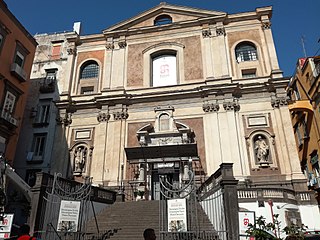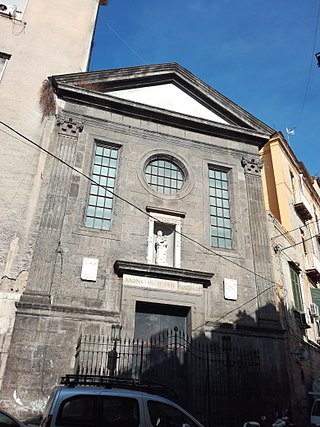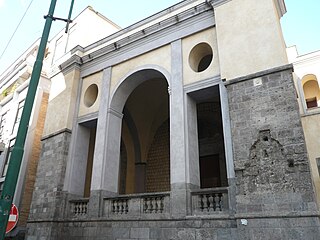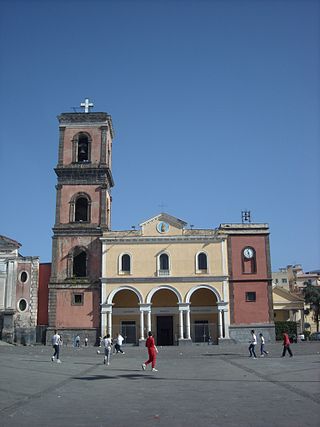
Santa Maria Donnregina Nuova is a church in central Naples, Italy. It is called Nuova ("new") to distinguish it from the older Angevin church of Santa Maria Donna Regina Vecchia.
This is a list of music conservatories in Naples, Italy.

Sant'Anna dei Lombardi,, and also known as Santa Maria di Monte Oliveto, is an ancient church and convent located in piazza Monteoliveto in central Naples, Italy. Across Monteoliveto street from the Fountain in the square is the Renaissance palace of Orsini di Gravina.

Via dei Tribunali is a street in the old historic center of Naples, Italy.

The Fontanelle cemetery in Naples is a charnel house, an ossuary, located in a cave in the tuff hillside in the Materdei section of the city. It is associated with a chapter in the folklore of the city. By the time the Spanish moved into the city in the early 16th century, there was already concern over where to locate cemeteries, and moves had been taken to locate graves outside of the city walls. Many Neapolitans, however, insisted on being interred in their local churches. To make space in the churches for the newly interred, undertakers started removing earlier remains outside the city to the cave, the future Fontanelle cemetery. The remains were interred shallowly and then joined in 1656 by thousands of anonymous corpses, victims of the great plague of that year.

The Ospedale degli Incurabili or Complesso degli Incurabili is an ancient and prominent hospital complex located on Via Maria Longo in central Naples, Italy. Part of the complex, including the remarkable pharmacy, are now the Museo delle arti sanitarie of Naples.

The Basilica of Santa Maria della Sanità is a basilica church located over the Catacombs of San Gaudioso, on a Piazza near where Via Sanità meets Via Teresa degli Scalzi, in the Rione of the Sanità, in Naples, Italy. The church is also called San Vincenzo or San Vincenzo della Sanità, due to the cult of an icon of San Vincenzo Ferrer, also called locally O' Monacone.

Santa Maria della Pace is a Roman Catholic church attached to a monastery and hospital, located on Via dei Tribunali corner with Via Castel Capuano, just after the piazzetta Sedil Capuano, in Naples, Italy.

Santa Maria dei Miracoli is a basilica church located in the largo dei Miracoli, near Via Foria in the city center of Naples, Italy. The neighborhood is named that of Miracoli or Miracles.
Santa Maria Assunta dei Pignatelli is a deconsecrated Roman Catholic church located at the end of Via Nilo in Naples, region of Campania, Italy. In the small piazza in front of the church is an ancient Roman statue of the Nile God.

Santa Maria delle Grazie Maggiore a Caponapoli or Santa Maria delle Grazie Maggiore is a church located in the historic center of Naples, Italy.

Santa Maria Regina Coeli is a Roman Catholic church in central Naples, Italy.

Santa Maria Materdomini is a Roman Catholic church located near piazzetta Fabrizio Pignatelli, in Naples, Italy

Santa Maria della Sapienza is a Roman Catholic church, located on Via Costantinopoli in central Naples, Italy.

The church of Santi Severino e Sossio and the annexed monastery are located on via Bartolommeo Capasso in Naples, Italy.

Sant'Agnello Maggiore, also called Sant'Aniello a Caponapoli or Santa Maria Intercede, is a church in the historical center of Naples, Italy.

The Catacombs of Saint Gaudiosus are underground paleo-Christian burial sites, located in the northern area of the city of Naples.

The church of Saint Barbara of the Gunners or Santa Barbara dei Cannonieri or Santa Barbara dei Cannonieri e dei Marinai is a small religious edifice in central Naples, Italy. It is located on Rua Catalana, near the church of San Giacomo degli Italiani. The church embedded in the Castel Nuovo of Naples, has also been called Santa Barbara.

The Basilica of Santa Maria a Pugliano is the main church in Ercolano and the oldest church in the area around Mount Vesuvius.

The Palazzo di Sangro di Casacalenda is an 18th-century aristocratic palace located across a piazza from the church of San Domenico Maggiore in central Naples, region of Campania, Italy. The East flank of the facade faces the facade of the church of Sant'Angelo a Nilo.



















